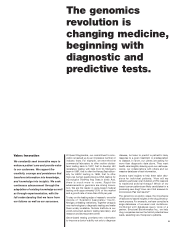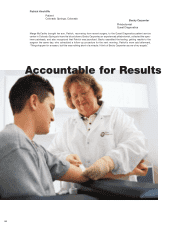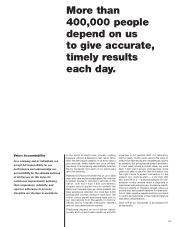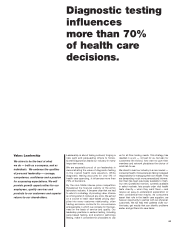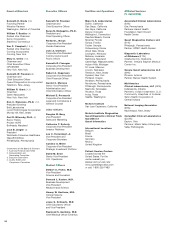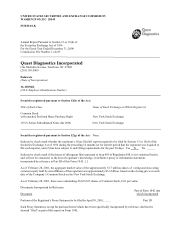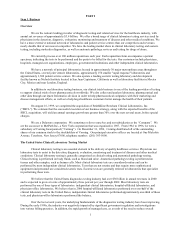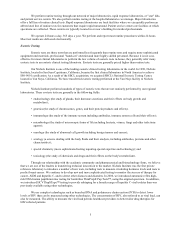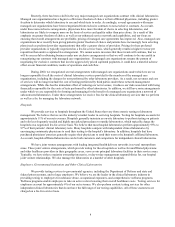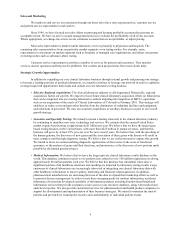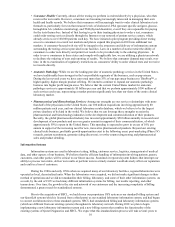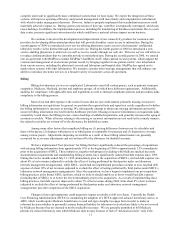Quest Diagnostics 2000 Annual Report Download - page 21
Download and view the complete annual report
Please find page 21 of the 2000 Quest Diagnostics annual report below. You can navigate through the pages in the report by either clicking on the pages listed below, or by using the keyword search tool below to find specific information within the annual report.
1
PART I
Item 1. Business
Overview
We are the nation's leading provider of diagnostic testing and related services for the healthcare industry, with
annual net revenues of approximately $3.4 billion. We offer a broad range of clinical laboratory testing services used by
physicians in the detection, diagnosis, evaluation, monitoring and treatment of diseases and other medical conditions. We
have a more extensive national network of laboratories and patient service centers than our competitors and revenues
nearly double that of our nearest competitor. We have the leading market share in clinical laboratory testing and esoteric
testing, including molecular diagnostics, as well as anatomic pathology services and testing for drugs of abuse.
We currently process over 100 million requisitions each year. Each requisition form accompanies a patient
specimen, indicating the tests to be performed and the party to be billed for the tests. Our customers include physicians,
hospitals, managed care organizations, employers, governmental institutions and other independent clinical laboratories.
We have a network of principal laboratories located in approximately 30 major metropolitan areas throughout
the United States, several joint venture laboratories, approximately 150 smaller "rapid response" laboratories and
approximately 1,300 patient service centers. We also operate a leading esoteric testing laboratory and development
facility known as Nichols Institute located in San Juan Capistrano, California as well as laboratory facilities in Mexico
City, Mexico and near London, England.
In addition to our laboratory testing business, our clinical trials business is one of the leading providers of testing
to support clinical trials of new pharmaceuticals worldwide. We also collect and analyze laboratory, pharmaceutical and
other data through our Quest Informatics division in order to help pharmaceutical companies with their marketing and
disease management efforts, as well as to help large healthcare customers better manage the health of their patients.
On August 16, 1999, we completed the acquisition of SmithKline Beecham Clinical Laboratories, Inc.
(“SBCL”). We estimate that the successful execution of our business strategy, along with the expected benefits of the
SBCL acquisition, will yield an annual earnings growth rate greater than 30% over the next several years, before special
charges.
We are a Delaware corporation. We sometimes refer to ourselves and our subsidiaries as the “Company”. We
are the successor to MetPath Inc., a New York corporation that was organized in 1967. From 1982 to 1996, we were a
subsidiary of Corning Incorporated (“Corning”). On December 31, 1996, Corning distributed all of the outstanding
shares of our common stock to the stockholders of Corning. Our principal executive offices are located at One Malcolm
Avenue, Teterboro, New Jersey 07608, telephone number: (201) 393-5000.
The United States Clinical Laboratory Testing Market
Clinical laboratory testing is an essential element in the delivery of quality healthcare services. Physicians use
laboratory tests to assist in the detection, diagnosis, evaluation, monitoring and treatment of diseases and other medical
conditions. Clinical laboratory testing is generally categorized as clinical testing and anatomical pathology testing.
Clinical testing is performed on body fluids, such as blood and urine. Anatomical pathology testing is performed on
tissues and other samples, such as human cells. Most clinical laboratory tests are considered routine and can be
performed by most independent clinical laboratories. Tests that are not routine and that require more sophisticated
equipment and personnel are considered esoteric tests. Esoteric tests are generally referred to laboratories that specialize
in performing those tests.
We believe that the United States diagnostics testing industry had over $30 billion in annual revenues in 2000
and is expected to grow at a rate of approximately three percent per year through 2002. Most laboratory tests are
performed by one of three types of laboratories: independent clinical laboratories; hospital-affiliated laboratories; and
physician-office laboratories. We believe that in 2000 hospital-affiliated laboratories performed over one-half of the
clinical laboratory tests in the United States, independent clinical laboratories performed approximately one-third of those
tests, and physician-office laboratories performed the balance.
Over the last several years, the underlying fundamentals of the diagnostics testing industry have been improving.
During the early 1990s, the industry was negatively impacted by significant government regulation and investigations
into various billing practices. In addition, the rapid growth of managed care, as a result of the need to reduce overall


